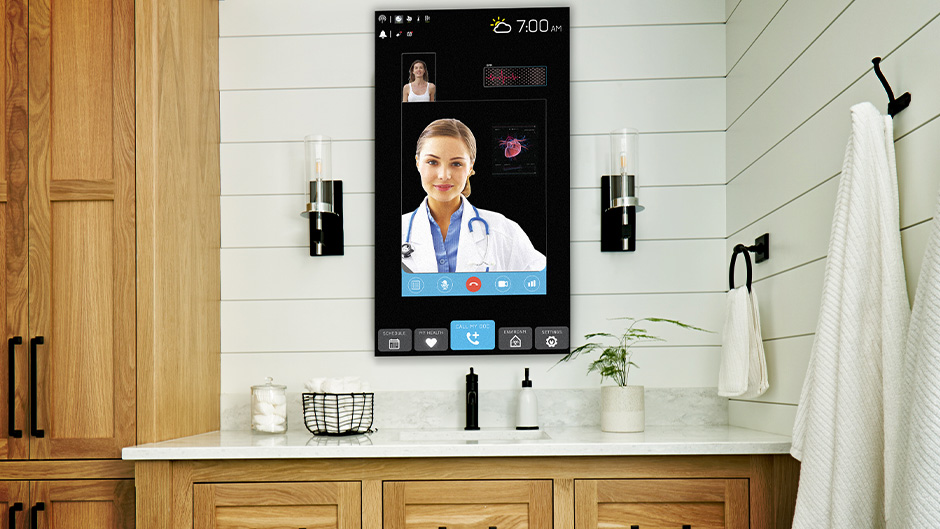Two University of Miami exhibits at the eMerge Americas 2023 conference could be game changers in the health field.
Imagine that as part of your morning routine, as you wash your face and brush your teeth, you could use a gesture to activate the LCD display integrated in the medicine cabinet door and watch your biometric data light up its two-way mirror.
That is what HealthHub will offer future users. Created by the RAD lab at the School of Architecture, the College of Arts and Sciences, and the Miller School of Medicine, the hub is an interdisciplinary project and will be displayed at the University of Miami booth at the Miami Beach Convention Center.
At a time in which demands on health care facilities continue to increase, HealthHub offers a safe, reliable method for monitoring, examining, and diagnosing.
“HealthHub is like having a hospital or clinic at home,” said Rodolphe “Rudy” el-Khoury, dean of the School of Architecture and director of the RAD lab. “Instead of getting blood work or the results of a physical once a year, you can get data on your health collected continuously and non-invasively.”
It also reminds patients to take their medications, which are lined up inside the cabinet behind the translucent LCD display that doubles as a mirror. “If the person forgets to take a medication, a light will start flashing on that bottle to warn them that they have not taken it,” said el-Khoury.
HealthHub features an array of biometric sensors developed by Sylvia Daunert, director of the Dr. J.T. Macdonald Biomedical Nanotechnology Institute at the Miller School of Medicine.
This design team thinks of HealthHub as a medical appliance at the center of an ecosystem of wearables and sensing devices designed to monitor the entire living environment. A blanket with embedded accelerometers will track the length and quality of a person’s sleep. Other technology will scan the entire living environment for toxins and allergens that may be affecting their health.
Patients also will be able to teleconference with their doctors using HealthHub as a specialized interface and the bathroom as a private examination room. Augmented reality features will enable the doctor to visualize ailment and body functions by layering relevant information on the patient’s reflection in the mirror, such as an anatomical display of internal organs, according to el-Khoury.
The University’s second health display at eMerge is Harvey, the Next-Generation Cardiopulmonary Patient Simulator. Harvey, the world’s first cardiopulmonary simulator, was created more than 50 years ago by Michael S. Gordon at the Miller School of Medicine and has been in use in hundreds of institutions, and in close to 70 countries throughout the world, to train learners in the health field.
Harvey is a sophisticated mannequin that can simulate up to 50 heart and lung conditions, said Dr. Barry Issenberg, professor of medicine and director of the Gordon Center for Simulation and Innovation in Medical Education. The improved Harvey comes in three skin shades—fair, medium, and dark—to more fully represent our diverse population, Issenberg noted.
At the conference, a next-generation Harvey will be on display for interaction with participants. Using a stethoscope, they will be able to listen for up to 50 cardiac and pulmonary conditions, including abnormal heart murmurs, heart sounds, and breath sounds.
“It replicates all the heart sounds and murmurs, breath sounds, arterial pulses that reflect when the heart beats, as well as neck and chest wall movements,” he said.
The new version of Harvey will simulate 50 conditions, but it offers more variations of those conditions, Issenberg pointed out.
For instance, a common condition is a leaky mitral valve, he noted. “In the past Harvey would offer two variations of that condition,” he said. “Now we have access to 10 variations. Health professions students can hear these conditions in a variety of ways making their detection on real patients more accurate.”
Visitors to the booth also will be able to put on augmented reality (AR) and virtual reality goggles and be able to explore a virtual clinic and a virtual Harvey. With the AR goggles they can examine Harvey, whose chest will be overlayed with an anatomical picture of the heart, and it will allow one to actually visualize where the condition is taking place, Issenberg said.
Harvey was created by Gordon in 1968. The Gordon Center is the only academic medical institution that develops, builds, and sells medical simulators.
In the future, developers will introduce a virtual female version of Harvey, and a pediatric one.
The University of Miami is a Titanium Sponsor of eMerge Americas. Visit the University’s research and technology showcase on April 20-21 at the Miami Beach Convention Center. Registration for an Unlimited TECH Pass is free for all University of Miami students, and faculty and staff members.

